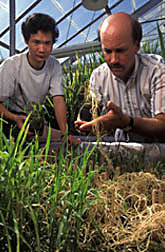New Rice Survives Extended Flooding
High-yielding variety also has uses for aerial seeding and weed control.
Too much of a good thing is sometimes not so good. Take rice. It needs water to grow in, but too much can kill it. Especially hard hit by flooding are some lesser developed areas of the world, where millions of people rely on rice as their major source of food.
Over the centuries, many Asian countries have developed intricate water delivery systems and rice paddies. But heavy rains can inundate fields before plants are fully grown and drown this labor-intensive crop.
In an effort to thwart nature, Asian farmers in flood-prone areas plant tail-growing rice cultivars. So if the flooding isn't too bad and doesn't stay long, the plants re-emerge and continue growing. Unfortunately, taller plants fail to deliver the yield of their shorter cousins.
Now an Agricultural Research Service scientist has succeeded in breeding short rice plants that have both of these valuable traits—high yields and tolerance to complete submergence for up to 2 weeks. This is margin enough for most flood-prone areas.
David J. Mackill started work about 15 years ago at the International Rice Research Institute in Manila, Republic of the Philippines. He was moving the genes that impart tolerance to flooding from low-yielding varieties to high-yielding strains. After 5 more years of research in the ARS Crops Pathology and Genetics Research Unit at Davis, California, Mackill has shown that the flood-resistance trait is mostly controlled by a single gene.
The new rice types would provide some relief to rice growers around the world who need increased rice yields to feed an ever-expanding population. They are Indica types that grow mainly in the tropics.
Though the new rices are not yet commercially available to growers, initial testing indicates that they will yield upwards of 5 tons per acre. This is about 20 to 40 percent more than traditional tall varieties and about the same as other high-yielding short types.
"We are now in the process of moving the gene into Japonica rices—the main type grown in more temperate areas of the world—so they, too, will have improved survivability. While water management is pretty sophisticated in the United States and unpredicted flooding is less of a problem, the trail could nevertheless be useful," says Mackill.
"For example, in California, airplanes seed vast acreages of pre-germinated Japonica rice directly into standing water. Some of this seed fails to survive the flooded fields. The flood-survival trait might improve seedling establishment."
Another benefit to the trait might be in controlling many of the most competitive, yield-robbing weeds. With rices that have more tolerance to flooding, growers could raise the water level in fields until the weeds die. And Mackill is now searching for other useful genes that give rice seedling vigor and resistance to stem rot disease.
Kenong Xu, a rice breeder from the Anhui Academy of Agricultural Science in China, has assisted Mackill for the past 2 years. They have grown rice plants in 3-foot-deep greenhouse flood tanks. Those that survived from 14 to 16 days of submergence became parents of the new strains.
Of the 520 million tons of rough rice produced annually in the world, about 90 percent is cultivated in Asia. U.S. production—mainly in Arkansas, California, Louisiana, Texas, and Missouri—ranges from 7 to 9 million tons per year. However, the United States was second only to Thailand in rice exports in 1994, accounting for 17 percent of world trade. -- By Dennis Senft, ARS.
USDA-ARS Crops Pathology and Genetics Research Unit, One Shields Avenue, University of California, Davis, CA 95616; phone (530)752-1137, fax (530) 754-7195.
"New Rice Survives Extended Flooding" was published in the October 1995 issue of Agricultural Research magazine.







